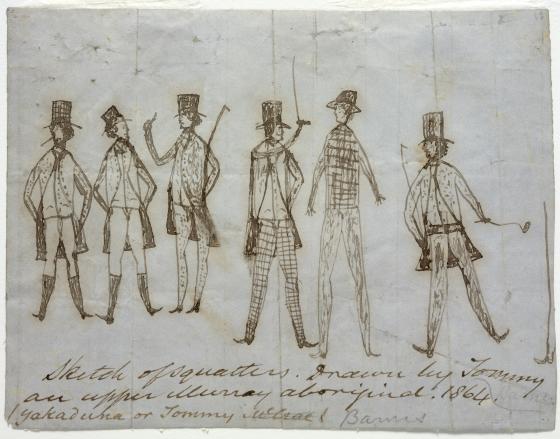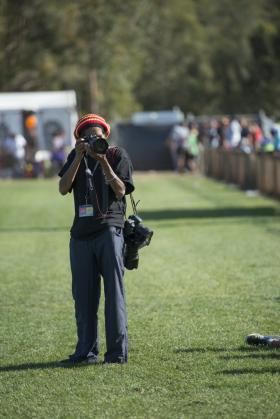Indigenous collecting
The Library’s extensive collections includes a vast array of material relating to Indigenous peoples of NSW.

Indigenous collections
The Library holds rich collections relating to Australian Indigenous history and culture, however a large majority of these materials are about, rather than by, Indigenous people and communities.
In 2015 the Indigenous Collecting Strategy was developed to proactively collect material created by Indigenous people, who have contributed, and continue to contribute, to the life of NSW and its communities.
Some of the highlights of the Library’s collections include:
- Works by Aboriginal people
- leaders: Pearl Mary (Gambanyi) Gibbs and Faith Bandler;
- authors: Ruby Langford Ginibi, Anita Heiss, Kevin Gilbert and David Unaipon;
- colonial artists: Mickey of Ulladulla; Tommy McRae; Johnny of Kangatong
- contemporary artists: Bronwyn Bancroft, Penny Evans, Karla Dickens, Esme Timbery, Danny Eastwood;
- photographers: Barbara McGrady, Jamie James, Michael Riley, Brenda Croft;
- cultural organisations: Aboriginal National Theatre; Boomalli;
- political organisations: Federal Council for the Advancement of Aborigines and Torres Strait Islanders; Aboriginal-Australian Fellowship; the Aborigines Progressive Association, and the Foundation for Aboriginal Affairs;
- oral histories: interviews with survivors of the Kinchela Boys Home; interviews with & by Mum Shirl & Elaine Syron;
- newspapers: The Abo Call; Koori Mail;
- leaders: Pearl Mary (Gambanyi) Gibbs and Faith Bandler;
- Works by non-Aboriginal people
These records document the life and activities of Aboriginal peoples from the earliest European explorations of Australia through to the present day.
They include papers and journals of:
- missionaries: for example, Reverends Lancelot Edward Threlkeld; William Ridley; ERB Gribble;
- organisations: such as the Anglican Board of Missions, Australian Indigenous Ministries (formerly Aboriginal Inland Mission) and the Presbyterian, Uniting and Methodist churches; Royal Anthropological Society of Australasia;
- surveyors: such as Sir Thomas Mitchell and Ludwig Leichhardt
- anthropologists: Alan Carroll, Herbert Basedow, Sir Walter Baldwin Spencer
- businesses: such as the Bassendean Station and the Berry Estate
- photographic collections: Henry King; JW Lindt; Tribune; Walkabout; PIX; Albert and Walter Stewart McColl
- colonial journals, letters and records: Accordion content.
- missionaries: for example, Reverends Lancelot Edward Threlkeld; William Ridley; ERB Gribble;
- Language materials and vocabularies
The Library's collections contain many rare and valuable documents and manuscripts featuring early attempts to transcribe, record and understand Aboriginal languages.
These records are vocabularies and other language material from Aboriginal and Torres Strait Islander peoples and date from 1788 to the 1930s. More than 40 different language groups from all Australian states and territories have been identified so far in over 200 original items within the State Library’s collections. Some of these items are the only known surviving records of these languages.
Compiled by Europeans – colonists, government officials, explorers, missionaries and travellers, this material includes vocabularies embedded in historical documents, letters, manuscripts, diaries, journals and printed works. These records are particularly valuable as it is thought that approximately only about 20 Aboriginal languages are now spoken comprehensively in Australia (Gamble, 2011), whereas at the time of Australian settlement in 1788, more than 250 Indigenous languages were actively spoken by Aboriginal and Torres Strait islander people. Because of this, the Indigenous language material held in the State Library of NSW collections is a precious asset to assist Indigenous communities, organisations and linguists to strengthen, preserve and revive Indigenous languages.
Explore the Rediscovering Indigenous Languages subject heading in the catalogue to learn more about material which has been identified in the Library's collections.
First Nations Collecting Strategy

The State Library of New South Wales actively collects and preserves material to illuminate who we are, where we are from and where we might be going. In 2023, the First Nations Collecting Strategy was updated to build on the foundations of the 2015 policy.
The Strategy makes clear recommendations for ensuring that Aboriginal and Torres Strait Islander voices are prioritised and celebrated as we aim to collect cultural materials that illustrate individual and community contributions in areas such as history, culture, activism, literature, oral histories and creative expression. Importantly this new strategy acknowledges the contested histories which the Library holds, and makes clear recommendations for ensuring that First Nations voices are prioritised and celebrated in our ongoing collecting activities.
Read the First Nations Collecting Strategy